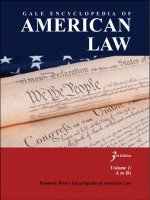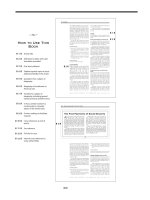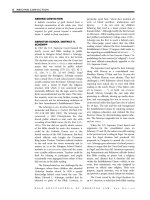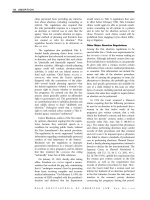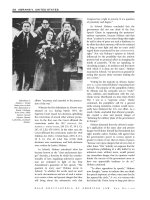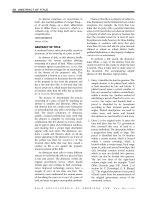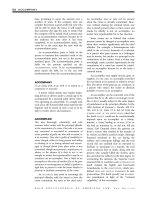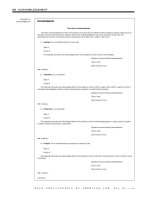Gale Encyclopedia Of American Law 3Rd Edition Volume 1 P11 ppsx
Bạn đang xem bản rút gọn của tài liệu. Xem và tải ngay bản đầy đủ của tài liệu tại đây (287.89 KB, 10 trang )
foreign commerce. The act was opposed by the
Federalists and the New England states, who
wanted to encourage trade with the British.
They feared that the Embargo Act would stifle
New England’s economy. Adams voted for the
Embargo Act, against the wishes of his party
and region, believing that it benefited the nation
as a whole.
Adams paid the price for breaking with his
party. Federalist leaders in Massachusetts—who
felt that Adams had betrayed them—elected
another man to the Senate several months
before the 1808 elections. Adams resigned, and
later that year, in a move indicative of his
political independence, attended a Democratic-
Republican congressional caucus meeting,
where
JAMES M ADISON was nominated for presi-
dent, thus allying himself with that party.
Adams attempted to retire from public life
and devote himself to a teaching position at
Harvard College, but the lure of public service
was too strong. In 1809 President Madison
persuaded him to accept an appointment as
minister to Russia. In 1814 and 1815 Adams
played a key role in the negotiations resulting in
the Treaty of Ghent, with the British, ending the
WAR OF 1812. The negotiations helped Adams
gain respect as a diplomat.
In 1817 President
JAMES MONROE called
Adams back to the United States to serve as
his
SECRETARY OF STATE. Adams’s most important
achievement in this office was the development
of the
MONROE DOCTRINE. It was Adams who
made the first declaration of that policy in July
1823, several months before Monroe formally
announced it in his annua l message to Con-
gress, on December 2, 1823. At that time, the
United States feared that Russia intended to
establish colonies in Alaska and, more important,
that the continental European states would
intervene in Central and South America to help
Spain recover its former colonies, which had won
their independence in a series of wars in the early
nineteenth century. Adams believed that the
Americas were no longer subject to any European
colonial establishment and that they should make
their own f oreign policies. The Monroe Doctrine
set forth three basic policy statements aimed at
protecting the Western Hemisphere from Euro-
pean intervention: North and South America
were closed to further European colonization; the
United States would not intervene in wars in
Europe and would not interfere with European
colonies and dependencies in the Americas; and
the United States would regard any intervention
by a European power in the independent states of
the Western Hemisphere as the manifestation of
an unfriendly disposition toward the United
States.
Adams served as secretary of state for the
entire eight years under President Monroe.
When the presidential election of 1824 came
around, Adams was considered a favorite; after
all, the previous two presidents, Madison and
Monroe, had also served as secretaries of state.
But 1824 was no normal year for politics in the
United States. All four candidates were mem-
bers of the same political part y, the
DEMOCRATIC-
REPUBLICAN PARTY, and party affiliation had given
way to sectionalism. Secretary of the Treasury
William Harris Crawford, of Georgia, who had
recently suffered a paralytic stroke, was nominat-
ed by a congressional caucus. The Tennessee
legislature nominated
ANDREW JACKSON, and the
Kentucky legislature nominated
HENRY CLAY.
Adams was nominated by an eastern faction of
the party in Boston. On Tuesday, November 9,
1824, voters went to the polls and cast 153,544
votes for Jackson, 108,740 for Adams, 46,618 for
Clay, and 47,136 for Crawford. (Figures from
Kane, Facts about the Presidents; figures in other
sources differ.) The electoral vote results were as
follows: Jackson, 99; Adams, 84; Crawford, 41;
and Clay, 37. As no candidate received a majority
of the electoral votes, the House of Representa-
tives was called upon to choose the president, as
set forth under Article II, Section 1, Clause 3, of
the Constitution. After Clay gave his support to
Adams, the House elected Adams the sixth
president in February 1825.
For one who had led so accomplished a life,
Adams must have viewed his presidency as a
failure. He got off to a rocky start when
Jackson’s supporters in Congress decried what
they called a corrupt bargain between Adams
and Clay. Only days after the House selected
Adams president, Clay was offered the office of
secretary of state, which he accepted. This deal
split the Democratic-Republican Party, and
Adams’s group became known as the National
Republicans. Jackson’s group fought with
Adams for the next four years.
Adams threw all his energies into the
presidency. In his inaugural address, he called
for an ambitious program of national improve-
ments including the construction of highways,
TO FURNISH THE
MEANS OF ACQUIRING
KNOWLEDGE IS
THE GREATEST
BENEFIT THAT CAN BE
CONFERRED UPON
MANKIND
.
—JOHN QUINCY
ADAMS
GALE ENCYCLOPEDIA OF AMERICAN LAW, 3RD E DITION
88 ADAMS, JOHN QUINCY
canals, weather stations, and a national univer-
sity. He urged Congress to use the powers of
government for the benefit of all people.
Congress disagreed. Many of the programs
advocated by Adams were not realized until
after his death.
Despite his best efforts, Adams felt worn
down by the burdens and demands of the
presidency. His personal reserve, austerity, and
coolness of manner prevented him from appeal-
ing to the imagination and affections of the
people. He had not even tried to defend himself
against the attacks of Jackson and his followers,
feeling that it was below the dignity of the
president to engage in political debate. Through-
out Adams’s presidency, Jackson gained in
popularity, so much so that in the elections of
1828, he defeated Adams by 178 electoral votes
to 83. Jackson won a popular vote proportionally
larger than that of any other presidential candi-
date during the rest of the 1800s.
Once again Adams sought to retire from
public life, but the people of Massachusetts
called him back. In 1830 he defeated two other
candidates and was elected to the U.S. House of
Representatives, representing a district from
Plymouth. When it was suggested to him that
his acceptance of this position would degrade a
former president, Adam s replied that no person
could be degraded by serving the people as a
representative in Congress, or, he added, as a
selectman. Indeed, Adams said that his election
as president was not half so gratifying as his
election to the House.
Adams shone brightly from 1831 to his
death in 1848. He remained independent of
party politics, and held important posts in
Congress, serving at times as chairman of the
Foreign Affairs Committee and of the Commit-
tee on Manufactures. Adams was conspicuous
as an opponent of the expansion of
SLAVERY and
was at heart an abolitionist, though he never
became one in the political sense of the word.
He took center stage during debates over the gag
rules, which resulted when abolitionists sent
many petitions to Congress urging that slavery
be abolished in the District of Columbia and the
new territories. Southern members of Congress
who did not want to discuss slave issues passed
a series of rules, known as the gag rules, that
kept the abolitionists’ petitions from being read
on the House floor, effectively blocking any
discussion of slavery. Adams fought the gag
rules as violations of the right of free speech and
the right of citizens to petition their government
as guaranteed in the
FIRST AMENDMENT.Asthe
leading opponent of the gag rules, Adams
became the person abolitionists sent their
petitions to. He, in turn , tried to have the
House consider those petitions, only to run up
against the gag rules. For several years Adams
tried unsuccessfully to have the rules repealed,
but he was able to win supporters to his side
each time he tried, and in 1844 he finally
succeeded in having the rules abolished.
Another contribution of Adams to the
antislavery cause was his championing of
Africans on the slave ship Amistad. The slaves
had mutinied off the coast of Cuba, capturing
their masters. The slaves, unfamiliar with
navigation, asked their captives to help them
sail to a country where slave trade was illegal.
The former masters took advantage of the
slaves’ navigational inexperience and directed
the ship into U.S. waters near Long Island,
hoping to find sympathetic U.S. auth orities.
Adams was one of two attorneys who argued the
case of the Africans before the U.S. Supreme
Court, defending the blacks as free people.
President
MARTIN VAN BUREN had taken the
position that the slaves must be returned to
their masters and to their inevitable death.
Adams helped win their freedom (United States
v. Libellants of Schooner Amistad, 40 U.S. [15
Pet.] 518, 10 L. Ed. 826 [1841]).
Adams’s support of the arts and sciences was
evident in his battle to uphold the dying wishes of
an eccentric Englishman named James Smithson.
Smithson was the illegitimate son of the first duke
of Northumberland. At his death in 1829, he
bequeathed his entire estate to his nephew. His
will further provided that if the nephew were to
die without heirs, which he did in 1835, the entire
estate was to be given to the U.S. government to
found what Smithson asked be called the
Smithsonian Institution, an establishment for
the increase and diffusion of knowledge. Adams
led a ten-year fight for acceptance of the
endowment, which was valued at $508,000 in
1835, and the Smithsonian Institution was
established on August 10, 1846.
On November 19, 1846, Adams suffered a
stroke, from which he never fully recovered. He
continued to serve in Congress until he suffered
a second stroke and collapsed in the House of
Representatives. He was carried from his seat to
GALE ENCYCLOPEDIA OF AMERICAN LAW, 3RD E DITION
ADAMS, JOHN QUINCY 89
the Speaker’s room, where he lay until his death
two days later, on February 23, 1848.
FURTHER READINGS
Kane, Joseph N. 2001. Facts about the Presidents:
A Compilation of Biographical and Historical Informa-
tion. 7th ed. New York: Wilson.
Nagel, Paul C. 1997. John Quincy Adams: A Public Life,
A Private Life. New York: Knopf.
Parsons, Lynn H. 1998. John Quincy Adams. Madison, Wis.:
Madison House.
Remini, Robert Vincent. 2002. John Quincy Adams. New
York: Times Books.
ADAPTATION
The act or process of modifying an object to render
it suitable for a particular or new purpose or
situation.
In the law of patents—grants by the
government to inventors for the exclusive right
to manufacture, use, or market inventions for a
term of years—adaptation denotes a category of
patentable inventions, which entails the appli-
cation of an existing product or process to a
new use, accompanied by the exercise of inven-
tive faculties. Federal law provides: “Whoever
invents or discovers any new and useful process,
machine, manufacture, or composition of matter,
or any new and useful improvement thereof,
may obtain a
PATENT therefore, subject to
the conditions and requirements of this title.”
35 U.S.C.A. §101.
The adaptation of a device to a different
field can constitute an invention if inventiveness
exists in the conception of new use and with
modifications necessary to render the device
applicable in the new field. The progressive
adaptation of well-known devices to new, but
similar, uses is merely a display of an expected
technical proficiency, which involves only the
exercise of common reason ing abilities upon
materials furnished by special knowledge ensu-
ing from continual practice. It, therefo re, does
not represent a patentable invention. Ingenuity
beyond the mere adaptation of teachings as
could be done by a skilled mechanic is required
to achieve a patentable invention; inventive
talent, rather than skill in adaptation, must be
manifested. To entitle a party to the benefit of
the patent statute, the device must not only be
new; it must be inventively new. The read-
aptation of old forms to new roles does not
constitute invention where there is no signifi-
cant alteration in the method of applying it or in
the nature of the result obtained. No invention
will be recognized if the new form of the result
has not previously been contemplated and,
irrespective of the remoteness of the new use
from the old, if no modifications in the old
device are necessary to adapt it to the new use.
Invention is generally not involved where an
old process, device, or method is applied to a
new subject or use that is analogous to the old
or to a new use or the production of a new
result in the same or analogous field. If the new
use is so comparable to the old that the concept
of adapting the device to the new use would
occur to a person proficient in the art and
interested in devising a method of changing the
intended function, there is no invention even
though significant alterations have been made.
The application of an old device to a new use is
normally patentable only if the new use is in a
different field or involves a completely novel
function. In addition, the physical modifica-
tions need not be extensive, as long as they are
essential to the objective.
In the law of copyrights the exclusive right
of the author of a literary project to reproduce,
publish, and sell his or her work, which is
granted by statute, adaptation refers to the
creation of a derivative work, which is protected
by federal
COPYRIGHT laws.
A derivative work involves a recasting or
translation process that incorporates preexisting
material capable of protection by copyright. An
adaptation is copyrighted if it meets the
requirement of originality, in the sense that
the author has created it by his or her own
proficiency, labor, and judgment without di-
rectly copying or subtly imitating the preexist-
ing material. Mere minor alterations will not
suffice. In addition the adapter must procure
the consent of the copyright owner of the
underlying work if he or she wants to copy from
such work. The copyright in a derivative work,
however, extends only to the material contrib-
uted by the adapter and does not affect the
copyright protection afforded to the preexisting
material.
The rise in the use of digital media has
caused new dilemmas in the area of copyright
law with respect to adaptations. Even average
technology users may make copies and adapt
the original works to their needs. Issues in this
area have focused upon
INTELLECTUAL PROPERTY
rights in the context of the INTERNET and
computer programs.
GALE ENCYCLOPEDIA OF AMERICAN LAW, 3RD E DITION
90 ADAPTATION
Even average computer users are capable of
copying digital music files and modifying them
through the use of software. The Internet
enables these user s to prepare these modifica-
tions and distribute them to a wide audience
using the Web,
E-MAIL, and other methods of
distribution. The Copyright Act of 1976 con-
tinues to protect the copyright holders, generally
requiring those who prepared derivative works to
obtain permission from the copyright holder (17
U.S.C.A. § 114(b) [1996]). However, enforce-
ment of these provisions has proven difficult and
led to a number of efforts, including those by the
Recording Industry Association of America, to
find new methods for protecting the rights of the
copyright holders.
A second cause of concern among copyright
owners is the ability of computer users to make
copies of computer programs and adopt these
programs to serve the users’ purposes. The
Copyright Act provides an exclusive right to
the copyright holders of computer programs and
allows owners of copies of these programs to
make additional copies only in limited circum-
stances (17 U.S.C.A. § 117 [1996]). Like sound
recordings, protection of these copyrights has
proven difficult, leading lawmakers to consider
a number of new options to protect these rights.
In the law of real property, with respect to
fixtures (articles that were
PERSONAL PROPERTY but
became part of the realty through annexation to
the premises), adaptation is the relationship
between the article and the use that is made of
the realty to which the article is annexed.
The prevailing view is that the adaptation or
appropriation of an article affixed to real
property for the purpose or use to which the
premises are devoted is an important consider-
ation in ascertaining its status as a fixture.
According to this theory, if the article facili tates
the realization of the purpose of the real
property, the annexor presumably intends it to
be a permanent accession. Numerous other
cases, however, allude to the adaptation of an
item to the use to which the premises are
designated, as merely on e of the tests or factors
that should or must be evaluated in determining
that it constitutes real property. Other cases
view the character of the use of the article
annexed as significant.
The special construction or fitting of an
article for location and use on certain land or in
a particular building, which mitigates against
use in another location, indicates that is was
intended to constitute a part of the land.
The adaptab ility of an annexed article for
use in another location is sometimes view ed as
demonstrating the retention of its character as
personalty (personal property), but this charac-
teristic is not conclusive. Articles not designed
to comprise the realty retain their character as
personalty.
FURTHER READINGS
Benn, Marvin N., and Richard J. Superfine. 1994. “§ 117—
The Right to Adapt into the Fourth Generation and the
Source Code Generator’s Dilemma.” John Marshall
Journal of Computer and Information Law 12 (spring).
Miller, Arthur R., and Michael H. Davis. 2007. Intellectual
Property: Patents, Trademarks, and Copyright in a
Nutshell. 4th ed. Eagan, MN: West.
Plotkin, Mark E., ed. 2003. E-Commerce Law & Business.
Frederick, MD: Aspen.
ADD-ON
A purchase of additional goods before payment is
made for goods already purchased.
An add-on may be covered by a clause in an
installment payment contract that allows the seller
to hold a security interest in the earlier goods until
full payment is made o n the later goods.
v
ADDAMS, JANE
Jane Addams, a pioneer in social reform, founded
Hull House, the first
SETTLEMENT house in the
United States, to serve the immigrant families
who came to Chicago at the beginning of the
industrial revolution. For nearly 50 years,
Addams worked relentlessly for improved living
and working co nditions for America’s urban
poor, for women’s suffrage, and for interna-
tional
PACIFISM.
Addams was the youngest of eight children,
born on September 6, 1860, to John H. and
Sarah Addams. Her mother died when she was
two years old, and her teenage sisters, Mary,
Martha, and Alice, took over her upbringing.
Her family followed the Quaker faith, and
valued hard work and change through peaceful
efforts. Addams idolized her father, whom she
described as a man of great integrity. He
remained a pivotal figure in her life until his
death in 1881.
Addams’s first exposure to urban poverty
occurred when she was six years old, during a
trip with her father to Freeport, Illinois. Upon
seeing the city’s garbage-filled streets and slum
GALE ENCYCLOPEDIA OF AMERICAN LAW, 3RD E DITION
ADDAMS, JANE 91
housing, she asked her father why the people
lived in such horrid houses. After her father told
her the people were too poor to have nicer
homes, she announced that she would buy a big
house when she was grown, where poor children
could come and play whenever they liked.
Addams suffered throughout her life from a
painful curved spine that caused her to walk
pigeon-toed. As a result, she was always self-
conscious about her appearance. She was a good
student and often helped classmates who were
having difficulties with their studies. After
graduating from high school in 1877, she
attended nearby Rockford Female Seminary,
one of the oldest institutions for female
education in the area. Rockford encouraged its
students to become missionaries, but Addams,
who struggled with her religious beliefs all her
life, refused to consider that vocation. While at
Rockford, she met Ellen Gates Starr, who would
later help her found Hull House. Reflecting
Addams’s emerging concern about the place of
women in America, she and Starr attempted to
convince the seminary to offer coursework
equivalent to that of men’s colleges. Eventually,
the seminary did become Rockford College.
Addams graduated from Rockford in 1881.
Several months later, she was devastated when
her father died of a ruptured appendix while on
a family vacation in Wisconsin. His death left
her a wealthy woman, and she decided to fulfill
her plan to attend the Women’s Medical
College of Philadelphia. Addams began her
studies that fall, but almost immediately the
back pain she had suffered all her life flared up,
forcing her to undergo back surgery.
During her lengthy recovery, Addams
toured Europe with her stepmother, Anna
Haldeman Addams. Throughout her trip,
Addams was struck by the poverty of the
industrialized countries she visited. At a fruit
and vegetable auction in London, she watched
as starving men and women fought over
decayed and bruised produce. As she wrote in
her autobiography, her impression was of
“myriads of hands, empty, pathetic, nerveless
and workworn, clutching forward for food
that was already unfit to eat.” She was also
appalled at the lack of concern for poor people
shown by better-off Europeans.
Jane Addams.
LIBRARY OF CONGRESS.
Jane Addams 1860–1935
❖
◆
❖
1860 Born,
Illinois
1861–65
American Civil War
◆◆
◆
◆◆
◆◆
1881 Graduated
from Rockford
Female Seminary
1889 Opened
Hull House, a
settlement
house in
Chicago slums
1910 Published
Twenty Years at Hull House
1915 Helped establish
Women's Peace Party
1920 Helped found ACLU
1914–18
World War I
1929 Stock market
crashed, Great
Depression began
1930 Published The
Second Twenty
Years at Hull House
1931 Awarded
Nobel Peace Prize
1935
Died
1939
World
War II
began
▼▼
▼▼
18501850
18751875
19001900
19251925
◆
◆
1920 Nineteenth Amendment became law,
giving women right to vote
GALE ENCYCLOPEDIA OF AMERICAN LAW, 3RD E DITION
92 ADDAMS, JANE
On her return home in 1885, Addams found
herself exhausted, depressed, and unsure of her
life’s purpose. On a second trip to Europe, she
visited Toynbee Hall, an experimental Oxford-
based project in London’s poverty-s tricken
East End. Educated young men had moved into
the area and were offering literacy classes,
art lessons, and other activities to residents.
Because the men actually settled in the area and
lived with the residents, Toynbee was called a
settlement house.
Addams decided to use Toynbee as a model
and establish a similar facility in the slums of
Chicago. With over a million residents, that
city was home to hundreds of thousands of
immigrants—from Germany, Ireland, Sweden,
Italy, Russia, Greece, and many other countries.
These desperate people were a ready source of
cheap labor for the Chicago factories, and their
poor wages forced them to live in overcrowded,
rat-infested tenements, surrounded by filthy,
garbage-filled streets. Journalist Lincoln Steffens
described the Chicago of that time as violent,
foul smelling, and lawless.
Addams enlisted the aid of her former
schoolmate, Starr, in her new venture. The
women first had to overcome the adamant
objections of friends and relatives who were
horrified that two educated, unmarried women
would consider living in the city’s slums. But
Addams and Starr soon found a house where
they could begin their work, the former
mansion of Cha rles J. Hull. Once a stately
country home, the house was now surrounded
by rundown, noisy city tenements. In the
beginning, Addams was able to rent only a
few rooms in the house, but eventually, Hull’s
heir, Helen Culver, gave her the entire house
and some surrounding land.
After several months of cleaning and
refurbishing, Addams and Starr opened Hull
House in September 1889. Initially the two
were met with great suspicion by the area’s
residents. Local priests warned their parishion-
ers the women might try to convert them to a
new
RELIGION, and street children threw garbage
and rocks at the house. But Addams and Starr
continued to greet their neighbors in a friendly
manner, and the residents soon discovered that
the women were concerned about their well-
being. They also found that the women would
sell them nourishing food for just a few pennies,
and they soon came to depend on Hull House.
In the first few years of the settlement
house, Addams established a kindergarten, a
women’s boarding house, the nation’s first
public playground, and a day care center for
mothers forced to leave their children alone for
as long as ten hours each day in order to work.
Hull House offered evening college extension
courses, English and art classes, a theater group,
and books and magazines for children and
adults. Observing the long hours and dangerous
working conditions that the neighborhood
children were forced to endure, Addams and
her friends soon began working for state regula-
tion of child labor, and went on to lobby in
Washington, D.C. At home, when city garbage
collectors continually ignored overflowing gar-
bage bins, Addams applied for and was appointed
to the position of ward garbage inspector, and
forced the trash collectors to remove the filth.
Addams described her work at Hull House
as an effort to conserve and push forward the
best of the community’s achievements. She
strove to respect and preserve the immigrants’
cultures, and the holidays of their various
nations were always celebrated at Hull House.
Among the volunteers who flocked to Hull
House to work with Addams were several
women who later brought about important
social reform. Julia C. Lathrop helped establish
Chicago’s first juvenile court. Dr. Alice Hamil-
ton worked in industrial medicine and con-
ducted studies that helped improve factory
conditions. Florence Kelley investigated sweat-
shops for the Illinois State Bureau of Labor and
helped establish
CHILD LABOR LAWS. Although
Addams developed a wide circle of influential
supporters because of her work, such as socialist
EUGENE V. DEBS and journalist Steffens, she also
occasionally lost admirers for the same reason.
Addams never wavered in her belief that the
same activities that caused her to lose some
supporters would help her to gain others.
In the first decade of the twentieth century,
Addams established herself as a prolific writer,
publishing Democracy and Social Ethics (1902),
Newer Ideals for Peace (1907), The Spirit of
Youth and the City Streets (1909), and the best-
selling first volume of her autobiography,
Twenty Years at Hull House (1910). During
these years, she began to turn her attention
more and more to women’s issues—particularly
the right to vote. In 1913, seven years before the
NINETEENTH AMENDMENT to the U.S. Constitution
PRIVATE BENEFI-
CENCE IS TOTALLY
INADEQUATE TO DEAL
WITH THE VAST
NUMBERS OF THE
CITY
’S DISINHERITED.
—JANE ADDAMS
GALE ENCYCLOPEDIA OF AMERICAN LAW, 3RD E DITION
ADDAMS, JANE 93
granted women the right to vote in all elections,
she helped secure the vote for women in
Chicago.
Addams’s work continued to expand be-
yond Hull House and women’s rights. In 1909
she supported the founding of the National
Association for the Advancement of Colored
People (
NAACP) and served on its executive
committee. In 1915 she helped establish the
Women’s Peace Party, and traveled to Europe to
attend the Internatio nal Women’s Peace Con-
ference in the Netherlands and carry the
message of peace to the countries fighting in
WORLD WAR I. Addams continued to hold to her
pacifist views even when the United States
entered the war in 1917, and she was blacklisted
as a result. The Daughters of the American
Revolution, a group that had once honored
Addams for her colonial ancestry, expelled her,
and she was shunned by many other supporters.
She continued her humanitarian work during
the war, however, helping the U.S. Department
of Food Administration to distribute food to
European allies.
Following the war, Addams also worked to
have food sent to the starving civilians in the
defeated countries, setting off yet another round
of criticism. In 1920, in response to increasing
attempts to stifle unpopular opinion in the
United States, Addams helped found the
AMERI-
CAN CIVIL LIBERTIES UNION
, dedicated to protecting
the individual’s right to believe, write, and speak
whatever he or she chooses.
By the 1930s the public’s bitterness toward
Addams had abated. In 1931 she was awarded
the Nobel Peace Prize, an achievement that
Addams felt justified her pacifist work to the
world. Frederick Stang, of the Nobel Committee
in Norway, said Addams had clung to her
idealism during a difficult time in which peace
was overshadowed. Addams went on to receive
fourteen honorary degrees, among them one
from Yale, the first honorary degree that school
had ever awarded to a woman.
In 1930 Addams completed her autobiog-
raphy with the publication of The Second
Twenty Years at Hull House. A few years later,
surgery revealed that Addams was suffering
from advanced cancer. She died in May 1935.
Shortly before her death, Addams was honored
at an event marking the twentieth anniversary
of the Women’s International League for Peace
and Freedom. In response to the many tributes
she received, she said she was driven by the fear
that she might give up too soon and fail to make
the one effort that might save the world.
FURTHER READINGS
Addams, Jane. 2002. Democracy and Social Ethics. Urbana:
Univ. of Illinois Press.
Davis, Allen Freeman. 2000. American Heroine: The Life and
Legend of Jane Addams. Chicago, Ill.: Ivan Dee.
Deegan, Mary Jo. 1988. Jane Addams and the Men of the
Chicago School, 1892–1918, New Brunswick, N.J.:
Transaction Books.
Linn, James Weber. 2000. Jane Addams: A Biography.
Urbana: Univ. of Illinois Press.
Polikoff, Barbara Garland. 1999. With One Bold Act: The
Story of Jane Addams. Chicago: Boswell Books.
ADDICT
Any individual who habitually uses any narcotic
drug so as to endanger the public morals, health,
safety, or welfare, or who is so drawn to the use of
such narcotic drugs as to have lost the power of
self-control with reference to his or her drug use.
Addiction to narcotics is not a crime in
itself, but that does not excuse violation of
related statutes. It may be an offense to be under
the influence of an illegal drug in a public place,
even though being an addict is not illegal. While
such a statute is intended to protect society
from the dangers of drug abuse and the
antisocial conduct of drug abusers, it generally
is not necessary for conviction to prove that the
DEFENDANT was disturbing the peace when
arrested.
CROSS REFERENCES
Drugs and Narcotics.
ADDITIONAL EXTENDED COVERAGE
A provision added to an insurance policy to extend
the scope of coverage to include further risks to
dwellings.
The provision may cover water damage
from the plumbing or heating systems,
VANDAL-
ISM
or MALICIOUS MISCHIEF, glass breakage, falling
trees, damage from ice or snow storms, or
additional risks not otherwise covered by the
LIABILITY policy.
ADDITIONAL INSTRUCTIONS
A charge given to a jury by a judge after the
original instructions to explain the law and guide
the jury in its decision making.
GALE ENCYCLOPEDIA OF AMERICAN LAW, 3RD E DITION
94 ADDICT
Additional instructions are frequently need-
ed after the jury has begun deliberations and
finds that it has a question concerning the
evidence, a point of law, or some part of the
original charge.
ADDITUR
The power of the trial court to assess damages or
increase the amount of an inadequate award made
by jury verdict, as a condition of a denial of a motion
for a new trial, with the consent of the defendant
whether or not the plaintiff consents to such action.
This is not allowed in the federal system.
Damages assessed by a jury may be
SET ASIDE
when the amount is shocking to the judicial
conscience—so grossly inadequate that it con-
stitutes a miscarriage of justice—or when it
appears that the jury was influenced by preju-
dice, corruption, passion, or mistake.
For example, a 61-year-old woman was
mugged in a hallway of her apartment building
after the landlord failed to replace a broken lock
on the back service entrance. She sustained a
broken shoulder, a broken arm, and numerous
cuts and bruises. Her medical bills amounted to
more than $2,500. She sued the landlord for his
negligent maintenance of the building, and the
jury returned a
VERDICT in her favor but awarded
damages of only $2,500. Her attorney immedi-
ately moved for a new trial on the ground that
the verdict was shockingly inadequate. The trial
judge ruled that the jury could not possibly have
calculated compensation for the woman’s pain
and suffering, an item that should have been
included under state law. The trial judge,
therefore, awarded an
ADDITUR of $15,000. The
effect of this order was to put the
DEFENDANT on
notice that he must either pay the $15,000 in
addition to the verdict of $2,500 or a new trial
would be held. The defendant weighed the
disadvantages of investing time and money in a
new trial and the risk of an even higher award of
monetary damages by a sympathetic jury. He
consented to the additur.
An additur is not justified solely because the
amount of damages is low. For example,
damages of $10,000 certainly will not compen-
sate the family of a forty-four-year-old man who
had been steadily employed as a plumber until he
was permanently disabled in an auto accident. In
such a case, however, the jury could have found
that the plaintiff’s
NEGLIGENCE contributed to the
cause of the accident and reduced the damages
proportionately, as is permitted in most states.
An award of additur is not permitted in
every state, nor is it allowed in the federal
courts. Under the rules that govern procedure
in the federal courts, a trial judge has the power
to set aside a verdict for a
PLAINTIFF on the
ground that the damages awarded are clearly
inadequate, but then the judge’sonly
RECOURSE is
to grant a new trial.
CROSS REFERENCES
Civil Procedure; Tri al.
ADDUCE
To present, offer, bring forward, or introduce.
For example, a
BILL OF PARTICULARS that lists
each of the plaint iff ’s demands may recite that it
contains all the evidence to be adduced at trial.
ADEMPTION
The failure of a gift of personal property—a
bequest—or of real property—a devise—to be
distributed according to the provisions of a
decedent’s will because the property no longer
belongs to the testator at the time of his or her
A man and woman inject themselves with heroin. Though
addiction to narcotics is not a crime in itself, addicts are not
excused from the violation of narcotics-related statutes.
AP IMAGES
GALE ENCYCLOPEDIA OF AMERICAN LAW, 3
RD E DITION
ADEMPTION 95
death or because the property has been substan-
tially changed.
There are two types of ademption: by
extinction and by satisfaction.
Extinction
Ademption by extinction occurs when a partic-
ular item of
PERSONAL PROPERTY or specially
designated real property is substantially changed
or not part of the testator’s estate when he or
she dies. For example, a
TESTATOR makes a will
giving her farm to her nephew and a diamond
watch to her niece. Before she dies, she sells the
farm and loses the watch. The proceeds of the
sale of the farm are traced to a bank account.
After the testator’s death, the nephew claims the
proceeds from the sale and the niece claims that
the executor of the estate should pay her the
value of the diamond watch. Neither claim will
be upheld. Once the farm is sold, the specific
devise is adeemed by extinction. The proceeds
from its sale are not its equivalent for
INHERI-
TANCE
purposes. In some states, however, if all of
the proceeds had not yet been paid, the nephew
would be entitled to receive the unpaid balance.
Because the testator no longer owns the
diamond watch when she dies, that specific
bequest is also adeemed by extinction.
Satisfaction
Ademption by satisfaction takes place when the
testator, during his or her lifetime, gives to his
or her heir all or a part of the gift he or she had
intended to give by his or her will. It applies to
both specific bequests and devises as well as to a
general bequest or legacy payable from the
general assets of the testator’s estate. If the
subject of the gift made while the testator is
alive is the same as the subject of a provision of
the will, many states presume that it is in place
of the
TESTAMENTARY gif t if there is a parent-child
or grandparent-grandchild relationship. Other-
wise, an ademption by satisfaction will not be
found unless there is independent evidence,
such as express statements or writings, that the
testator intended this to occur. A father makes a
will leaving his ski house to his daughter and
$25,000 to his son. Before death, he gives the
daughter the deed to the ski house and he gives
the son $15,000 with which to complete medical
school. After the father’s death, the daughter
will get nothing, while the son will get $10,000.
After the son received the $15,000 from his
father, there was an ademp tion by satisfaction
of the
GENERAL LEGACY of $25,000 to the extent of
the size of the lifetime gift, $15,000. The son is
entitled to receive the remaining $10,000 of the
original general legacy. Because there was a
parent-child relationship, there was no need for
independent proof that the $15,000 gift was
intended to adeem the gift under the will.
FURTHER READINGS
Lundwall, Mary Kay. 1993. “The Case against the Ademp-
tion by Extinction Rule: A Proposal for Reform.”
Gonzaga Law Review 29 (fall).
McEowen, Roger. 2009. “Court Decides Ademption Case.”
AgDM Whole Farm Legal and Taxes Recent Iowa Opinions
(May). Available online at tate.
edu/agdm/articles/mceowen/McEowOpinionsMay07a.
html; website home page: tate.
edu (accessed August 28, 2009).
Volkmer, Ronald R. 2000. “Doctrine of Ademption in the
Law of Wills.” Estate Planning 27 (March-April).
ADEQUATE
Sufficient; equal to what is required; suitable to
the case or occasion.
A law that requires
PUBLIC UTILITIES to
provide adequate service does not create a right
for customers to sue the electric company
whenever the meat in their freezers spoils
because of a power outage in the absence of
NEGLIGENCE. Service does not have to be perfect
in order to meet a standard of adequacy.
ADEQUATE REMEDY AT LAW
Sufficient compensation by way of monetary
damages.
Courts will not grant equitable remedies,
such as
SPECIFIC PERFORMANCE or injunctions,
where monetary damages can afford complete
legal relief. An
EQUITABLE REMEDY interferes much
more with the defendant’s freedom of action
than an order directing the
DEFENDANT to pay for
the harm he or she has caused, and it is much
more difficult for a court to supervise and
enforce judgments giving some relief other than
money. Courts, therefore, will compensate an
injured party whenever possible with monetary
damages; this remedy has been called the
remedy at law since the days when courts of
equity and courts at law were different.
ADHESION CONTRACT
A type of contract, a legally binding agreement
between two parties to do a certain thing, in which
one side has all the bargaining power and uses it
GALE ENCYCLOPEDIA OF AMERICAN LAW, 3RD E DITION
96 ADEQUATE
to write the contract primarily to his or h er
advantage.
An example of an
ADHESION CONTRACT is a
standardized contract form that offers goods or
services to consumers on essentially a “take it or
leave it” basis without giving consumers realistic
opportunities to negotiate term s that would
benefit their interests. When this occurs, the
consumer cannot obtain the desired product or
service unless he or she acquiesces to the form
contract.
There is nothing unenforceable or even
wrong about adhesion contracts. In fact, most
businesses would never conclude their volume
of transactions if it were necessary to negotiate
all the terms of every
CONSUMER CREDIT contract.
Insurance contracts and residential leases are
other kinds of adhesion contracts. This does not
mean, however, that all adhesion contracts are
valid. Many adhesion contracts are
UNCONSCIO-
NABLE
; they are so unfair to the weaker party that
a court will refuse to enforce them. An example
would be severe
PENALTY provisions for failure to
pay loan installm ents promptly that are physi-
cally hidden by small print located in the middle
of an obscure paragraph of a lengthy loan
agreement. In such a case a court can find that
there is no meeting of the minds of the
PARTIES
to the contract and that the weaker party has
not accepted the terms of the contract.
ADJACENT
Lying near or close to; neighboring.
Adjacent means that objects or parcels of
land are not widely separated, though perhaps
they are not actually touching; but adjoining
implies that they are united so closely that no
other object comes between them.
ADJECTIVE LAW
The aggregate of rules of procedure or practice.
Also called adjectival law, as opposed to that body
of law that the courts are established to administer
(called substantive law), it means the rules
according to which the substantive law is adminis-
tered, e.g., Rules of Civil Procedure. That part of
the law that provides a method for enforcing or
maintaining rights, or obtaining redress for their
invasion. Pertains to and prescribes the practice,
method, procedure, or legal machinery by which
substantive law is enforced or made effective.
CROSS REFERENCE
Civil Procedure.
ADJOINING LANDOWNERS
Those persons, such as next-door and backyard
neighbors, who own lands that share common
boundaries and therefore have mutual rights,
duties, and liabilities.
The
RECIPROCAL rights and obligations of
ADJOINING LANDOWNERS existed at COMMON LAW
but have been modified by various state laws
and court decisions.
Rights, Duties, and Liabilities
Landowners are expected to use their property
reasonably without unduly interfering with the
rights of the owners of contiguous land.
Anything that a person does that appropriates
adjoining land or substantially deprives an
adjoining owner of the reasonable enjoyment
of his or her property is an unlawful use of one’s
property. A man buys a house in a residentially
zoned area and converts it into an office
building. He paves the backyard for a parking
lot but encroaches two feet beyond his property
into the lot of the adjoining landowner. His use
of the property is unlawful for a number of
reasons. He has appropriated his neighbor’s
land and substantially interfered with his
neighbor’s right to use it. His neighbor may
sue him in a tort action fo r the
NUISANCE created
and, if successful, the neighbor will be awarded
damages and an
INJUNCTION to stop the unlawful
use of the land. In addition, the purchaser has
violated zoning laws by using residential property
for commercial purposes without seeking a
VARIANCE.
Property owners have the right to grade or
change the level of their la nd or to build
foundations or embankments as long as proper
precautions are taken, such as building a
retaining wall to prevent soil from spilling upon
adjoining land. If permitted by law, landowners
may blast on their own property but will be
liable for damages caused by debris thrown onto
adjoining land.
Lateral Support A landowner has a legally
enforceable right to
LATERAL SUPPORT from an
adjoining landowner. Lateral support is the
right to have one’s land in its natural condition
held in place from the sides by the neighboring
land so that it will not fall away. Land is
considered in its natural condition if it has no
GALE ENCYCLOPEDIA OF AMERICAN LAW, 3RD E DITION
ADJOINING LANDOWNERS 97

